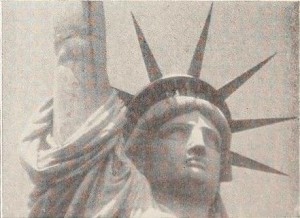
"Terry Manos is one New Yorker who has outdone himself (and all other native or visiting filmers) in recording on film the glittering surface of the world's greatest metropolis and America's premier tourist attraction. For The $24 Purchase is authoritatively stamped with the unfailing precision of the Manos technique, the perfection of his lighting and exposures, the beauty and balance of his compositions. Accompanying it is a musical score (admirably recorded) that is generally fresh and germane to the subject, a narrative that (although burdened unduly by the factual trivia of the tourist barker) is delivered with professional skill. In other words, here is a superb visual document. But a document only. For The $24 Purchase records only that surface city which the eye may see. Missing from its makeup are the searching, individual comments on that city of one human mind. Missing also — and perhaps more importantly — are the evocative emotions of one human heart, a heart reacting freely and unafraid of emotion to Manhattan's towers and tenements, to her opulent splendor and her economic ghettos. The film — tragically, if you will — has omitted any message. And, perhaps only by the margin of this omission, it has missed greatness as well." Movie Makers, Dec. 1952, 340.
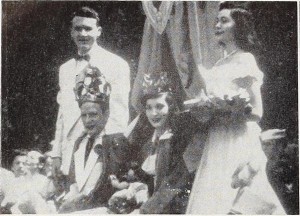
"With the help of almost unbelievable luck from the weather man, Helen C. Welsh has achieved a high level of what is essentially newsreel filming. Her subject matter is in itself appealing — displays of tulips in a public park, children wearing amazing holiday headgear, dancers performing Old World figures, all climaxed by the pageantry of the coronation of a new king and queen of the festival. But Miss Welsh handles it expertly. Her viewpoints are varied and her camera work accomplished, while a wisely sparse and well recorded narrative ties the whole presentation into an attractive package. Albany's Tulip Festival is colorful, entertaining and fulsome as a record of a city's spring holiday." Movie Makers, Dec. 1950, 464.
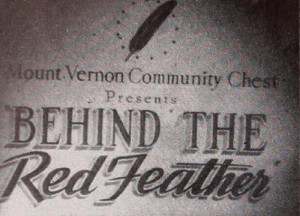
"Made to support a Community Chest campaign, Behind the Red Feather shows how various social welfare agencies in a community help to forestall juvenile delinquency, care for the aged, the sick and the poor and, in general, make a town a better place to live in. As a connecting link between a necessarily episodic series of sequences, a red feather, the Community Chest symbol, floats into the opening scene of the activities of each agency. Walter Bergmann has recorded this community project with understanding and warmth, and Ralph Bellamy contributed his services in recording on disc an excellently written narrative." Movie Makers, Dec. 1947, 536.
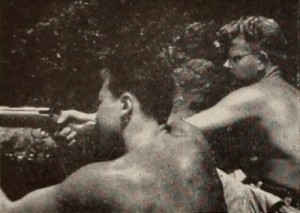
"It takes a true craftsman to catch all the intimate and informal scenes that make a first rate vacation film, particularly when his exposure problems are complicated by the sunlight and shadows of a thickly wooded lake shore. But George Mesaros has succeeded in producing the sort of vacation record that most filmers only dream about. Mr. Mesaros has mastered his technical problems with an expert's hand and has turned out a stunning, vital movie of a summer outing in the Saranac Lake region. Faced with non-cooperative fellow campers, he had to be prepared to set up his tripod at a moment's notice; but the candid air of the proceedings on the screen is ample recompense for his vigilance. Bluff Island Idyll is a vivid testament to the importance of human interest and to the appeal of simple, everyday activities when they are properly sequenced and edited." Movie Makers, Dec. 1947, 513.
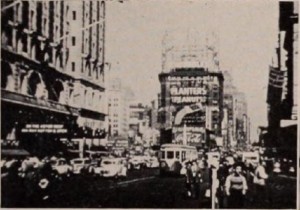
"Harley H. Bixler, a technician, has been inspired with the might of America, and he has interpreted it according to his lights. In Cavalcade of America, taking our entire country as his canvas, he has painted in, with striking chromatic images, the physical and industrial high lights of our heritage. Here are the sinews of strength, awaiting only the activating force of human endeavor to turn them to the path of power. Here are the mills and the mines, the oil and the electricity, the farms and the factories without equal in our modern world. Mr. Bixler interprets his fine pictorial document with a narrative that is usually vivid but sometimes matter of fact and accompanies the whole with recorded music. Cavalcade of America is a striking study of a tremendous subject." Movie Makers, Dec. 1940, 602.
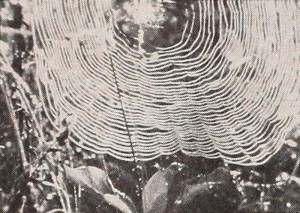
"Combining the sensitivity of an artist and a camera skill that theoretically only professional experts could acquire, Robert P. Kehoe has produced, in Chromatic Rhapsody, a film that would command the amazed admiration of any movie club in the country. This beautiful picture can only be described as a scenic — a scenic held together rather tenuously by editing to create a symphonic arrangement of color and to associate scenes with the seasons. It is in the sheer beauty of color cinematography that Chromatic Rhapsody excels. This reviewer has never seen, in any medium, more gorgeous color photographs of autumnal foliage and winter landscapes. One is so impressed with the flawless color that he is inclined to suspect that nature puts on a special show for Mr. Kehoe. The truth is probably that Mr. Kehoe has a special understanding of nature and an intuitional sensitivity to light and color. For the rest, as Mr. Kehoe would say, he simply follows exposure instructions. The film is marred somewhat by lack of complete camera steadiness, the only flaw in an otherwise superb cinematic accomplishment. A charming musical score, arranged by double turntable, accompanies the movie's presentation." Movie Makers, Dec. 1939, 634.
"A record of the Toronto Film Society's visit to George Eastman House in Rochester, New York. Includes re-filmed excerpts from some of the classic films screened for the society members during their visit" British Columbia Archives.
"Carl Weagant's sea epic, The Cruise Of The Carlsark, 3000 ft., 16mm., is a complete film record of the voyage of the ketch, Carlsark, across the Atlantic. Three Cornell men began the adventurous trip at Ithaca, N. Y., sailing through the Erie Canal system into the St. Lawrence and thence out into the Atlantic. Crossing the ocean in the little yawl, they cruised through the Mediterranean and returned home, stopping at the Canaries. The film record of the trip, made by Mr. Weagant, who was skipper as well as cameraman, is almost as important an advent in the annals of amateur movie making as the trip itself is in yachting circles. Excellent in exposure throughout, the picture contains few of the errors that would have been excusable. The continuity follows the chart of the voyage but the reels of sea scenes in the midst of the film can be considered as a separate subject. These scenes, telling the every day life aboard the ketch and the exciting incidents on the trip, are as interesting and as well photographed as any amateur made sea pictures that have come to the attention of League headquarters." Movie Makers, Dec. 1930, 759.
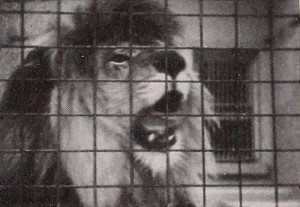
"A Day at the Zoo is a lively and pleasing film of a family's visit to the New York Zoological Gardens. The youngsters of the family discover the Children's Zoo and make the acquaintance of farmyard animals. They feed the chickens and pet the lambs while Father and Mother look on. The larger and stranger beasts in the main part of the Zoological Gardens are next pictured; the children feed them, too, but at a safer distance. In this film, Walter Bergmann has produced the best type of informal zoo picture — a story with human interest, enlivened with a sense of humor." Movie Makers, Dec. 1943, 477.
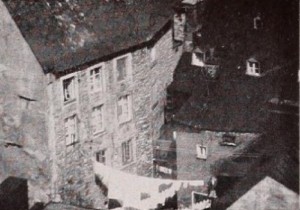
"A schoolboy in need of material for a geography theme launches Five Days From Home, as Dad gets out the movie projector and shows Son the cine harvest of his summer holiday. Among the points covered in a whirlwind auto trip from New York to Canada are Quebec City, Montmorency Falls, a Canadian pulpwood mill and Ausable Chasm, in New York State. Mannie Lovitch's handling of these subjects is always competent, occasionally excellent. His inquiring camera found many scenes of quaint charm in the old St. Lawrence city, and his full scale visual treatment of the pulp mill is sustained in interest by a superb bit of scoring with modern music by Virgil Thompson. Of especial note is Mr. Lovitch's mobile cross-cutting of the three to four themes which make up his coverage of the usually difficult Ausable Chasm." Movie Makers, Dec. 1948, 493.
Total Pages: 4